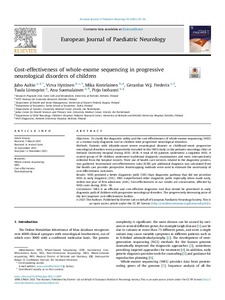Cost-effectiveness of whole-exome sequencing in progressive neurological disorders of children
Aaltio Juho; Hyttinen Virva; Kortelainen Mika; Frederix Gerardus W.J.; Lönnqvist Tuula; Suomalainen Anu; Isohanni Pirjo
https://urn.fi/URN:NBN:fi-fe2022021619489
Tiivistelmä
Objectives
To clarify the diagnostic utility and the cost-effectiveness of whole-exome sequencing (WES) as a routine early-diagnostic tool in children with progressive neurological disorders.
Methods
Patients with infantile-onset severe neurological diseases or childhood-onset progressive neurological disorders were prospectively recruited to this WES study, in the pediatric neurology clinic at Helsinki University Hospital during 2016–2018. A total of 48 patients underwent a singleton WES. A control group of 49 children underwent traditional diagnostic examinations and were retrospectively collected from the hospital records. Their use of health care services, related to the diagnostic process, was gathered. Incremental cost-effectiveness ratio (ICER) per additional diagnosis was calculated from the health care provider perspective. Bootstrapping methods were used to estimate the uncertainty of cost-effectiveness outcomes.
Results
WES provided a better diagnostic yield (38%) than diagnostic pathway that did not prioritize WES in early diagnosis (25%). WES outperformed other diagnostic paths especially when made early, within one year of first admission (44%). Cost-effectiveness in our results are conservative, affected by WES costs during 2016–18.
Conclusions
WES is an efficient and cost-effective diagnostic tool that should be prioritized in early diagnostic path of children with progressive neurological disorders. The progressively decreasing price of the test improves cost-effectiveness further.
Kokoelmat
- Rinnakkaistallenteet [27094]
